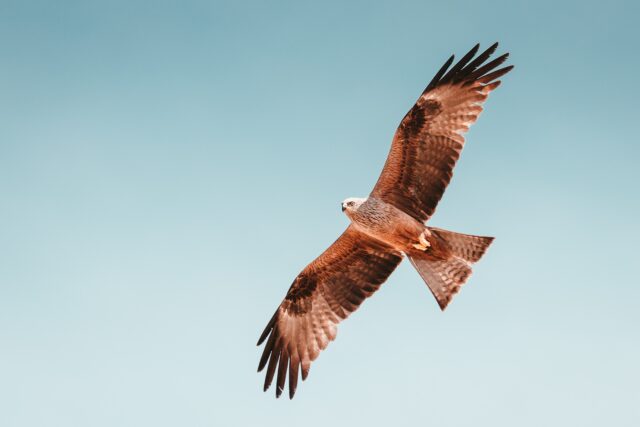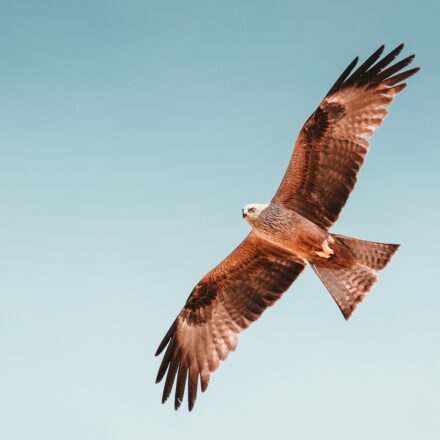Humans aren’t the only snowbirds who flock to Florida each year for sunshine.
Every fall, millions of birds in North America migrate south in search of warmer weather, defying strong winds and predators, guided by the stars and the Earth’s magnetic field.
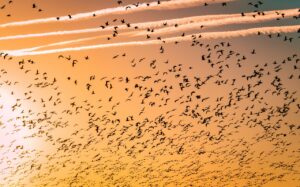
“As we sleep, there are billions of birds flying undercover,” says Kyle Horton, an assistant professor at Colorado State University who studies bird migration.
And yet, few humans are aware of this mass migration simply because we can’t see it. It turns out that one of the biggest challenges birds face on their journey is the light that emanates from our homes and office buildings. In fact, one research study co-authored by Horton found that the migratory patterns of as many as 1.1 million birds were altered by the light installation at the 9/11 Memorial and Museum in New York City. Some estimates show that between 100 million and 1 billion birds are killed every year from colliding into a building.
“To have birds fly a thousand kilometers just to hit a window is quite tragic,” Horton says. “Turning off lights at night can help reduce that probability considerably.”
But that begs the question: How do people know when to turn off the lights? BirdCast has the answers.
A forecast for bird migration based on radar data
At its core, BirdCast relies on 23 years of weather data (from 1995 to 2017) from the Next Generation Weather Radar (NEXRAD) system to predict when birds will take off. The result is a map of the U.S. that looks a lot like what you might see on your local news channel during the weather segment, except different colors are used to indicate where birds are flying that night. Yellow, for example, is used when bird traffic is extremely high, compared to purple, which represents low activity.
The first iteration of BirdCast was rolled out in 1999, “the dawn of the internet,” says Andrew Farnsworth, a senior research associate in the Center for Avian Population Studies at the Cornell Lab of Ornithology. Farnsworth has been involved with BirdCast since the very beginning, when the project was funded by the Environmental Protection Agency (EPA) to help determine if farmers should alter the timing of pesticide application during bird migration season. Back then, the team used floppy disks, manually downloaded radar data via satellite and used a simple spreadsheet to do the forecasting. “The whole notion of cloud computing was an exploratory dream at that point,” Farnsworth says.
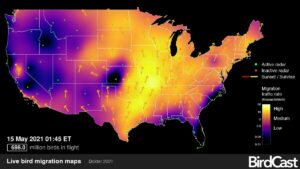
About a decade later, the team won an award from the National Science Foundation that allowed them to develop BirdCast into what it is today: a powerful bird migration prediction tool made possible by big data analytics and machine learning.
“The basis of these forecasts relies on the large archive of data from weather radars across the United States,” says Benjamin Van Doren, a postdoctoral associate at the Cornell Lab of Ornithology, who has worked on BirdCast, alongside Horton and Farnsworth. “These radars are sending out beams of energy to the atmosphere,” Van Doren says. And in addition to recording weather events like rain, snow and hail, radar can be used to record bird movement. Essentially, the goal of BirdCast was “to do the opposite of what the meteorologists do”—filter out weather events from radar imagery so that only bird traffic would remain.
To do so, Horton and Van Doren partnered with Dan Sheldon, a computer scientist at the University of Massachusetts Amherst, to develop a “classifier,” a deep learning algorithm, that could be trained to automatically identify and extract precipitation from radar images. As such, millions of radar images were screened to differentiate weather events from bird movement, such that the BirdCast team “can quantify when and where birds were migrating on any day, any time back to the early ’90s,” Van Doren says.
What weather factors matter most?
In order to predict when birds will migrate, BirdCast researchers need to identify which weather events in the past prompted migration and how much certain factors mattered, such as temperature, air pressure, wind and humidity. If similar weather conditions were to occur in the future, birds would likely exhibit the same behavior.
Researchers used an open-source software program called XGBoost—which stands for extreme gradient boosting—to develop a model “based on lots of bifurcating trees.” Van Doren likens the process to a family genealogy tree, but one that deals with different types of weather conditions instead of people.
Van Doren says the model functions by asking a series of questions to arrive at a prediction. “It’s like a flowchart, essentially,” he says, noting that the model considers factors such as the direction the wind is blowing and whether or not it’s raining.
Meteorologists get a lot of flack for not getting it right, but we don’t hear about all the times they do get it right, which is often.
—Kyle Horton, assistant professor, Colorado State University
“It’s much more complex than this, but you work your way down the tree after you’ve essentially answered all the questions,” he says. “The model is doing all this behind the scenes very quickly.”
Of all the factors that were incorporated, the researchers found that high temperatures coincided the most with birds’ tendency to migrate. When the temperature rises, birds see it as a green light: time to get going.
When birders look at the BirdCast website to check on migration timing, they will see a forecast map predicting migration three hours after the local sunset; information is updated automatically every six hours during migration season. The downside is that BirdCast can only do as well as the weather forecast, but fortunately forecasters do get it right quite often.
“Meteorologists get a lot of flack for not getting it right, but we don’t hear about all the times they do get it right, which is often,” Horton says.
How climate change is affecting bird migration
Having the ability to forecast bird migration—and watch birds’ movements in real time on radar—is incredibly helpful today when extreme weather is becoming more common.
“It’s impossible to avoid climate change when thinking about bird migration or really most aspects of biology these days, for better or worse,” Van Doren says. “We’re seeing lots of changes in the timing of migration.”

For example, Van Doren says birds are migrating earlier in spring because of warmer weather. BirdCast has been helpful because it relies on years and years of data. In order to spot trends, you need to have a long-term perspective to draw upon.
“A difference of seven days or 10 days or even less than that can make a huge difference in the success of a migration and therefore the success of a bird breeding season and the population,” Van Doren says. “Bird migration and climate change is part of a larger phenomenon of how birds and animals are responding to these myriad environmental changes that we’re observing.”
Legislation is the ultimate goal
Dozens of cities in the U.S. already have “Lights Out” events to raise awareness of the need to turn off building lights. States and municipalities like New York City are also passing legislation to make buildings more amenable to birds by constructing the exterior in a way that makes them more identifiable to birds.
“We hope that the research we do translates ultimately to these kinds of permanent systemic legislative changes,” Van Doren says.
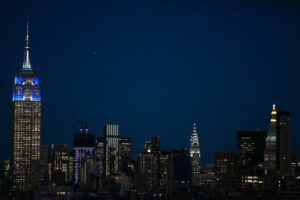
Protecting birds is crucial. One study showed that nearly 3 billion birds have been lost in the last five decades, and the impact is already being felt. Birds play an important role in controlling the insect and pest population and act as pollinators. In return, one easy thing people can do to help them during spring and fall migration season is to turn off exterior lighting and inside the home as much as possible.
“As much light as you can remove, you should,” Farnsworth says. “We can see that when you turn off individual windows inside buildings that it has a benefit in terms of reducing the number of birds that collide with those windows.”
Microphones in the sky, birders on the ground
One drawback of BirdCast is that it can’t drill down to identify a specific species that is flying on any given night. However, many of these birds are vocalizing as they fly, short chirps known as “flight calls,” which are generally species-specific. “If you record it, a computer can do a pretty good job of separating the call between a Tennessee warbler and a blackpoll warbler, for instance,” Horton says.
“It’s aspirational, we’re not there yet, but if you had lots of microphones monitoring the skies across the U.S. or North America in an automated way, the data coming in could be processed through an algorithm, then split out to detect the species. That would start filling in a lot of the gaps that we have from the radar perspective,” Horton says.
Horton and Van Doren are currently working on an improvement to BirdCast that will incorporate geographical location data, so that they can drill down to determine where birds are stopping to catch a breather. “It sounds like a trivial addition, but it adds a lot more complexity to the model itself,” Van Doren says.
Having information on where birds like to have their layovers is valuable for conservation efforts. For example, if researchers have detailed information on where birds are stopping, then extra attention can be paid to protecting and turning off lights in certain areas, whether it’s a wildlife refuge or an urban park.
Having regular citizen scientists on the ground helps, too. “I would definitely suggest anyone interested in collecting and contributing data on bird sightings use Cornell’s eBird app,” Van Doren says. “I think that the next frontier is being able to link our inferences about nocturnal migration to what’s happening on the ground.
Lead photo of a black kite by Martin Adams/Unsplash
